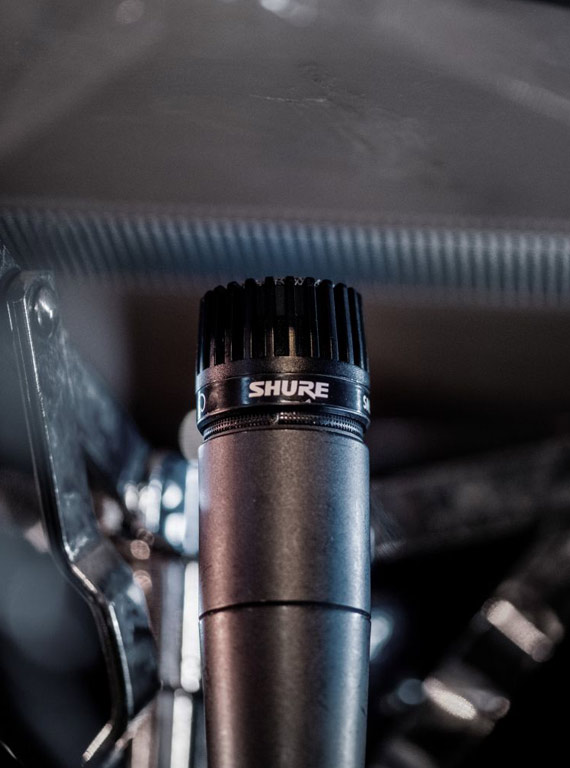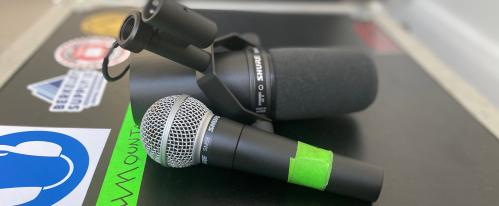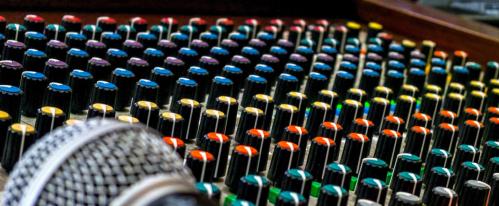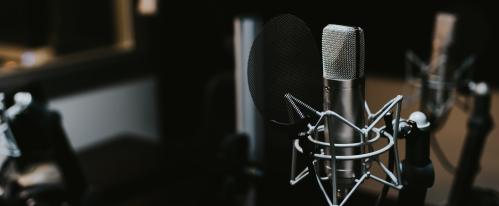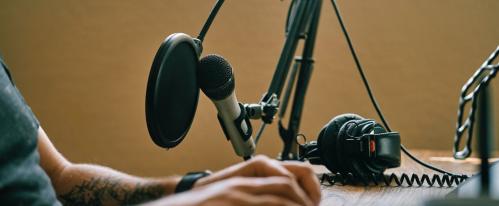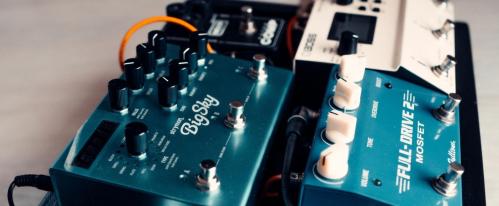We answer the questions: why is the Shure SM57 so popular, why is the SM57 so good for guitar cabs - and is it OK for vocals?
We’re continuing our holy trinity of industry-standard Shure mics with our next article on the Shure SM57, where we aim to answer the question: “Why is the Shure SM57 so popular?”.
We’ve covered the Shure SM7B and the Shure SM58 - recommended reading for those interested in choosing the right Shure microphone.
If you’ve ever heard a guitar, snare, or brass instrument on a recording, you’ve likely heard the Shure SM57. Since it was created in 1965, this has become the absolute industry standard microphone for recording guitar cabinets, snare drums and louder sound sources such as brass instruments. In fact, it’s been the go-to mic for every US president’s speech since 1965 – which is kind of a big deal.
This unassuming, slightly weird-looking microphone may not look particularly impressive, but it’s responsible for some of the most famous guitar and vocal recordings in musical history and is widely considered the best dynamic microphone ever created for both the stage and studio.
A bold statement, for sure. Justified? You bet.
Used by the likes of John Lennon, the historic Elton John Dodgers Stadium LA 1975 performance, The Killers on ‘Hot Fuss’, and Nirvana’s nevermind for vocals and guitar. It’s the go-to mic for powerful sounds.
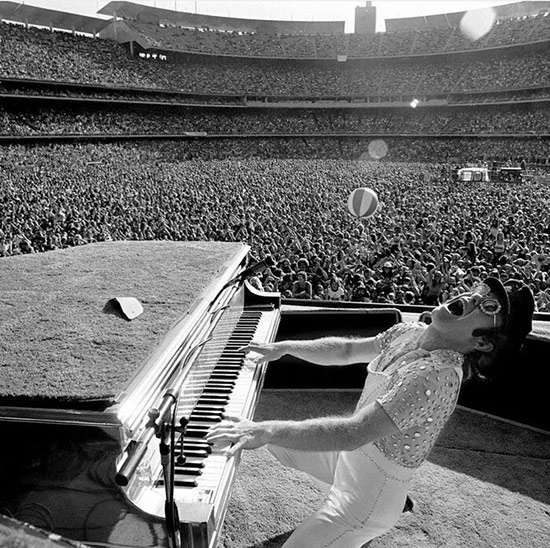
But why?
In this article, we’ll highlight 7 key features and benefits of the Shure SM57, and answer some of the most commonly asked questions - including why it’s good for vocals, and why the SM57 is good for guitar cabs. We’ll show you examples of why the Shure SM57 is so popular, and why this relatively “cheap” microphone is the absolute GOAT for guitar and snare sounds.
Why is the Shure SM57 so Popular?
In short, the Shure SM57 is so popular due to its robust transient response, high SPL, lack of distortion at high volumes, the tight cardioid polar pattern for superior off-axis rejection and absolute indestructible design. It just won’t die no matter how loud you play or how much you (ab)use it.
Short answer: just buy it. If you record anything at all, you’ll need it.
There are plenty of articles out there explaining the history of the Shure SM57 – but we’re all about the benefits and key reasons why it’s so popular.
Let’s dig in.
7 Reasons You Need the Shure SM57 Microphone and Major Benefits
Here are 7 reasons why you need the Shure SM57 in your studio and in your home recording or live set-up. In this list we’ll look at the following features and benefits of the SM57:
- High SPL & robust transient response
- Tailored frequency
- Off-axis rejection / polar pattern
- Flexibility
- Construction
- Versatility
- Price
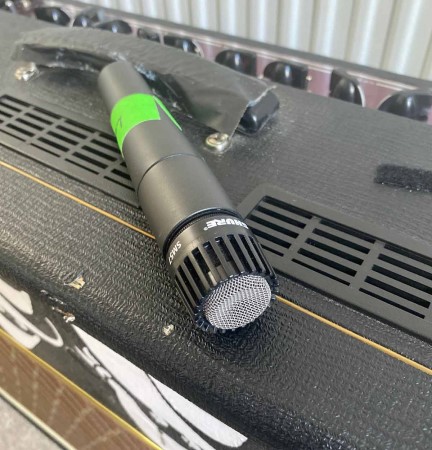
1. High SPL and Robust Transient Response
The Shure SM57 is renowned for its extremely high SPL and robust transient response. In a nutshell, the Shure SM57 won’t distort when you’re recording at high volumes. Where other microphones may distort at high volumes - especially if it’s a sound with a short, sharp burst, like a drum snare, for example - the Shure SM57 can handle it.
Why is this important?
When you’re recording or mic’ing up a live band, you want the subtle nuances of your playing to be heard as well as the hard-hitting emotion. You want dynamics to be felt. The Shure SM57 responds beautifully to hard-hitting snare drums just as much as it does to soft sound sources.
Where some microphones may distort if you “dig in” and play louder on a guitar riff or hit harder on a snare drum, the Shure SM57 shrugs it off without distorting.
Some microphones can withstand loud sound sources over an extended period of time with a little mixing, they can’t necessarily handle the short sharp bursts. The SM57 can. This is especially important for preserving dynamics in a performance. No matter how hard you hit, play or sing, it won’t distort.
The high SPL or Sound Pressure Level is equally as important.
The Shure SM57 has an SPL of 190 – which is louder than a space shuttle taking off (measured at 180db at 10 metres). This means your microphone can theoretically record the sound of a NASA space shuttle taking off without distorting.
Recording your cranked Marshall cab is going to be fine.
The average guitar cabinet cranked up to full volume can reach around 115dB at 1 metre. The fact that the Shure SM57 can handle this high sound pressure level at close range is one of the main reasons it's the industry standard guitar amplifier microphone.
You can crank your tube amp as loud as you want to get that sweet saturation and capture every single nuance of your playing at high volume without the microphone ever distorting. You can record full brass bands, a thrash metal snare drum and anything you want to throw at it and the mic will capture everything in detail.
This empowers producers and live engineers as they can have guitar amps as loud as they want and record in crystal clear detail.
2. Tailored Frequency Response
A major benefit of the Shure SM57 is its tailored frequency response of 40 Hz - 15 kHz. This tailored response has been specifically designed to bring out the best possible sound for drums, guitars, and vocals.
Due to the fact the SM57 is a dynamic microphone with a contoured frequency response, it’s not as sensitive as a condenser, but this is a good thing as you can actually use the microphone to manipulate and use the proximity effect to your liking.
The proximity effect causes the bass or “boom” to become pronounced the closer the mic is positioned to the sound source. So, if you want to record vocals with the Shure SM57 and you prefer a deeper tonality, just get closer to it and the bass will increase. If you have a deeper voice, sit back a little and bring out the higher frequencies and increased presence.
If you’re a guitarist, you’ll love the fact that the SM57 brings out the mid-frequencies with the added presence boost. This ensures you get a clean sound that is not muddied by the bass of your amp or too high and “sparkly” it’s a controlled, powerful sound. This is one of the reasons the likes of Butch Vig loved using it on the guitars for ‘Nevermind’ – it brought out the raw power without too much bass or high-end treble.
Live engineers prefer this stye of frequency response too as it helps them create a cleaner sound in a live mix – their not wrestling with unwanted high or low frequencies, ensuring your amp or snare just sounds great!
The Shure SM57 can also enhance and bring out the detail in bass amps as the tailored frequency response reduces the lower frequencies, ensuring your bass sounds powerful and punchy.
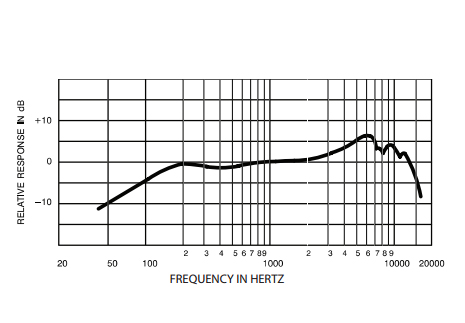
3. Cardioid Polar Pattern – Excellent Off-Axis Rejection
The Shure SM57 has a very tight cardioid polar pattern, which when placed up close could almost be mistaken for a supercardioid polar pattern. This means that you get a highly controlled and focused sound coming through the microphone. Producers can pick up the sound of the amp and singers will enjoy using them as the directional nature of the mic means you won’t get feedback from foldback speakers – probably one of the reasons Elton John loved using the Shure SM57 so much!
You’ll see from the image below (look at the solid line) just how little the microphone will pick up around it. If you place the mic further back (left image) the mic will pick up a more roomy sound, but still provide a controlled representation of your sound source. Place it closer (right image) and the microphone will reject almost everything around it. This cardioid polar pattern is one of the key benefits of the Shure SM57 and a main reason engineers and recording artists love it. No matter what’s going on around you, the mic won’t pick it up. This means you won’t get ant split from cymbals or other drums or hear any other musicians playing when recording in a live scenario. The live sound engineer loves it too because they don’t have to wrestle with other sounds on stage – it’s just your amp, vocals or snare that they’re picking up and mixing.
Live, in the studio or recording at home – you only record what the mic is pointing at which is why it’s ideal for a manner of different applications.
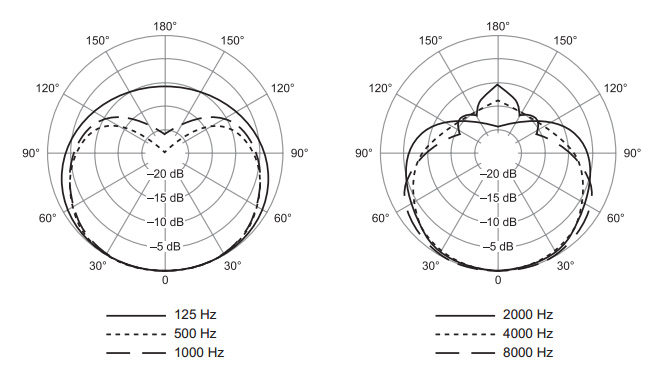
4. Flexibility/Versatility
The Shure SM57 is predominantly used for guitar cabs and snares, owing to the transient response and high SPL which we’ve discussed. However, it’s an extremely versatile microphone that lends itself particularly well to vocals, both live and in the studio. Kurt Cobain recorded his vocals with the Shure SM57 for ‘Nevermind’, Brandon Flowers used the SM57 to record his vocals for ‘Hot Fuss’ - both pretty great endorsements.
In the studio and live scenario, the mic perfectly rejects off-axis sound so you can use it anywhere, but the way you place it allows you to create a myriad of different sonic signatures.
Just take a look at the recommended placements for mic’ing and recording a full band featuring the Shure SM57 and get some tips to improve your sound.
Whether you’re recording loud sound sources like a trumpet, drum or screaming vocal or softer sounds from an acoustic singer-songwriter – the Shure SM57 can handle it – just bring the microphone closer or move it slightly back depending on the sound you want.
5. Design
The signature design and look of the Shure SM57 has a functional purpose. The Shure SM57 capsule is closer to the top of the grille. This ensures you can experiment with the bass and proximity effect when close mic’ing. The Shure SM57’s design also provides a higher output above 5 kHz which means the higher registers of your snare, guitar or brass sound will cut through the mix.
The Shure SM57 is perfect for vocals of course, but the smaller mesh grille will only provide so much protection from plosives at close range. If you do want to record vocals with it, we suggest the SM57 windshield!
6. Durability
The Shure SM57’s unique construction and indestructible design harks back to when Shure was a contractor for the United States Military in WWII. They produced a range of military-grade items for the US Army and continued with this construction process and quality control with their microphones. A quick Google will throw up hundreds of videos shooting, burying and throwing the SM57 only for it to keep recording and working.
This means it can handle the most demanding touring schedules, survive the odd pint of beer (or worse) being thrown on-stage, a drop or a knock - and keep providing high-quality sound for decades.
The integrated pneumatic shock mount counters vibration-induced movement which means the capsule is going to be fine even if you drop it. And you will.
7. Price
The Shure SM57 is very much affordable, which is surprising when you think about how influential it’s been in the world of music. This low cost is a key reason the Shure SM57 is so popular as everyone can afford it. Whether you’re a beginner home studio enthusiast looking for a new mic to take your sound to pro-level quality or an experienced audio engineer in need of something that will last a lifetime of pub bands and rock n’ roll stages, you’ll appreciate and benefit from the Shure SM57’s reliability.
The Shure SM57 is THE industry-standard guitar cabinet microphone, and just like the SM58 or SM7B a must-have microphone for musicians and audio engineers that will outlive you and won’t break the bank.
Is the Shure SM57 Worth It?
Yes. The Shure SM57 is absolutely worth it if you want a microphone that provides professional-level sound in the studio and on-stage on a budget. This is a must-have microphone for any musician or sound engineer that you won’t ever regret buying.
It’s indestructible, allows for high SPL level recording, maintains the quality of your instrument and can be used to record a full range of instruments and sound sources. When you buy this, you begin your journey into world-class sound recording.
You’ll be glad you did.
Shure SM57 FAQs
Is the Shure SM57 good for bass amps?
Yes. The key reason the Shure SM57 is good for bass amps is down to its frequency response. The contoured frequency reduces the amount of low-end the further you move the mic away. This means you can place the mic up close to your bass amp and enjoy a punchy, detailed sound without the proximity effect or “boominess” becoming overbearing. This is ideal for retaining the detail and power in your bass sound in hollow venues.
Move the mic back slightly and you can clean up the sound of your bass and reduce the low-end – ideal for venues where the floor is solid.
Why is the SM57 so good for guitar?
The Shure SM57 is great for guitar thanks to the frequency response which brings out the detail of your sound and the ability to capture high SPL levels without distorting. Your guitar amp can be cranked loud and the SM57 will still record all the detail and subtle nuances of your playing. It’s actually the industry standard guitar cabinet microphone used by Butch Vig, Steve Albini and many more producers.
It’s also great on acoustic guitars too.
What is the Shure SM57 best for?
The Shure Sm57’s ability to capture a high SPL of 190dB means it’s best for loud sound sources like a guitar cab, brass instrument or drum kit. The SM57 is the industry standard snare mic as it can withstand high transient noises (short sharp bursts of noise) from a snare without distorting.
Is the Shure SM57 OK for vocals?
Yes. The SM57 is also perfect for vocals if you want a transparent yet detailed sound with added presence. We recommend a windshield though due to the smaller pop filter.
Is the Shure SM57 a good mic?
Yes. The Shure SM57 is an industry-standard microphone that will propel your sound recordings into the pro-level realm. It’s beginner-friendly, and everyone from first-time audio engineers to world-class producers have one in their arsenal.
How long does an SM57 last? How durable is the SM57?
The Shure SM57 has been built to last a lifetime. The case is made with enamel-coated metal, a polycarbonate grille with stainless steel screen and a pneumatic shock mount system to keep the capsule safe from knocks and bumps. Breaking this is almost impossible unless you throw it into mount doom.
Is Shure SM57 good for recording?
Yes. The Shure SM57 is an industry-standard recording microphone that responds extremely well to different placements.
Why is the Shure SM57 good for snare?
The combination of high SPL capability and transient response means the Shure Sm57 can handle any size of snare or volume. The contoured frequency response reduces the unwanted high and low frequencies leaving the detail and power of the snare intact This microphone preserves the sound of your snare, whether it’s wood, brass or steel.
Does the Shure SM57 need phantom power?
No. the Shure SM57 does not need phantom power as it is a dynamic mic. Phantom power will not damage the Shure SM57, so don’t worry if you forget to turn it off.
Is a Shure SM57 good for live performance?
Absolutely. The incredible off-axis rejection means it won’t pick up anything else around the mic. The contoured 40 Hz - 15 kHz frequency response makes it easier for sound engineers to mix and control the sound thanks to the lack of low and high-end frequency peaks.
Final Thoughts On The SM57
The Shure SM57 has been relied upon to capture world-class sound for decades. From studio engineers to US presidents, vocalists to guitarists – there’s nothing it can’t do. We can guarantee you have an album with an SM57 on as it has earned a ubiquitous presence in the music industry thanks to its low price, perfect sound quality and hard-wearing construction.
Your sound will thank you for buying one.
Need help picking out a new microphone? Check out our range of new studio equipment here or call us on 0151 448 2089 and check out your local store to speak to one of our Experts about your needs.

